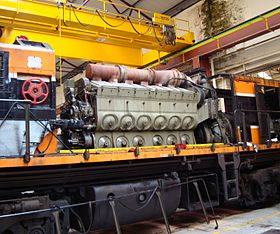
Back EMD 645 Danish EMD 645 Spanish EMD 645系エンジン Japanese EMD 645 Korean EMD 645 Portuguese 易安迪645系列柴油机 Chinese
This article includes a list of general references, but it lacks sufficient corresponding inline citations. (February 2008) |
| EMD 645 | |
|---|---|
 An EMD 12-645E3 turbocharged engine, installed in an Iarnród Eireann 071 class locomotive | |
| Overview | |
| Manufacturer | Electro-Motive Division of General Motors |
| Also called | E-Engine and F-Engine |
| Production | 1965–1983; limited runs through the 1990s |
| Layout | |
| Configuration | 45° Vee in V6, V8, V12, V16, or V20 |
| Displacement | 3,870 to 12,900 cu in (63.4 to 211.4 L) 645 cu in (10.6 L) per cylinder |
| Cylinder bore | 9+1⁄16 in (230 mm) |
| Piston stroke | 10 in (254 mm) |
| Cylinder block material | flat, formed and rolled structural steel members, and steel forgings, integrated into a weldment |
| Cylinder head material | cast iron, one per cylinder |
| Valvetrain | Intake ports in each cylinder liner, 4 exhaust valves in each cylinder head |
| Compression ratio | 14.5:1 |
| RPM range | |
| Idle speed | 200 |
| Max. engine speed | 950 |
| Combustion | |
| Supercharger | One or two Roots-type blower |
| Turbocharger | Single, clutch driven |
| Fuel system | Unit Injector |
| Management | Mechanical (Woodward governor) |
| Fuel type | Diesel |
| Oil system | Forced lubrication system, Wet sump |
| Cooling system | Liquid cooled |
| Output | |
| Power output | 750 to 4,200 hp (560 to 3,130 kW) |
| Chronology | |
| Predecessor | EMD 567 |
| Successor | EMD 710 |
The EMD 645 is a family of two-stroke diesel engines that was designed and manufactured by the Electro-Motive Division of General Motors. While the 645 series was intended primarily for locomotive, marine and stationary engine use, one 16-cylinder version powered the 33-19 "Titan" prototype haul truck designed by GM's Terex division
The 645 series was an evolution of the earlier 567 series and a precursor to the later 710 series. First introduced in 1965, the EMD 645 series remained in production on a by-request basis long after it was replaced by the 710, and most 645 service parts are still in production. The EMD 645 engine series is currently supported by Electro-Motive Diesel, Inc., which purchased the assets of the Electro-Motive Division from General Motors in 2005. EMD is currently owned by Progress Rail (since 2010).
In 1951, E. W. Kettering wrote a paper for the ASME entitled, History and Development of the 567 Series General Motors Locomotive Engine,[1] which goes into great detail about the technical obstacles that were encountered during the development of the 567 engine. These same considerations apply to the 645 and 710, as these engines were a logical extension of the 567C, by applying a cylinder bore increase, 645, and a cylinder bore increase and a stroke increase, 710, to achieve a greater power output, without changing the external size of the engines, or their weight, thereby achieving significant improvements in power per unit volume and power per unit weight.
Due to emissions restrictions these engines have been gradually phased out for the four-stroke alternatives.
- ^ Kettering, E.W. (November 29, 1951). History and Development of the 567 Series General Motors Locomotive Engine. ASME 1951 Annual Meeting. Atlantic City, New Jersey: Electro-Motive Division, General Motors Corporation.